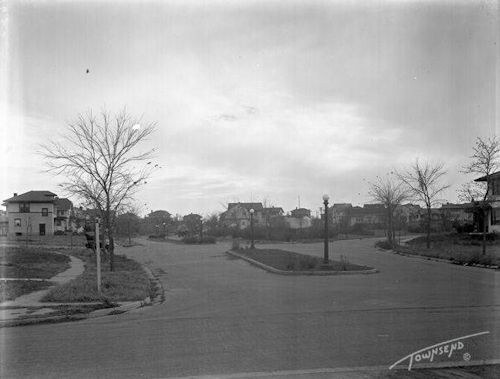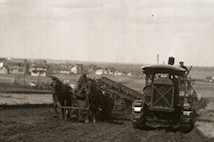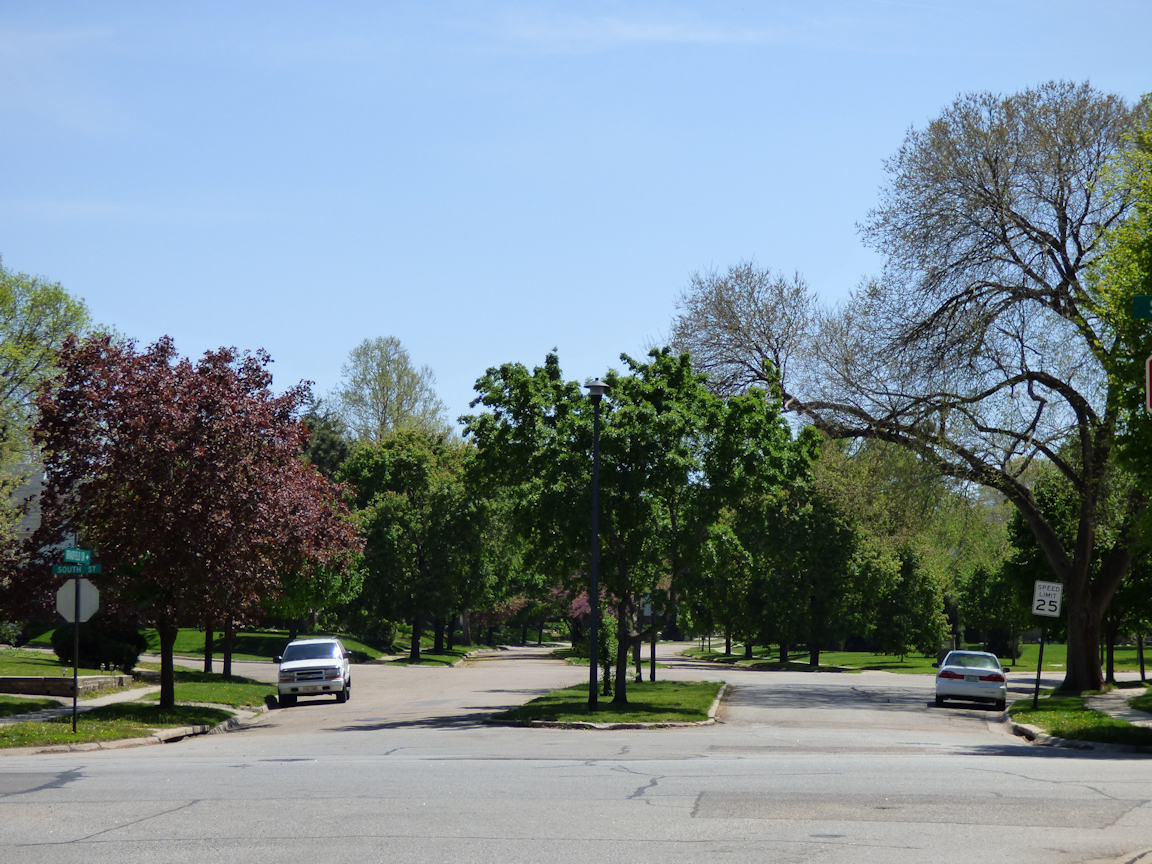
 The first house on Bradfield Drive was built in 1917 and the last in 1940. Along the way, streets were cut and paved as needed. New machinery helped with the process, as seen in the photograph at right. With the brand name “Best” stamped above the grill, the machine used to pull the equipment that cut and lifted the sod has a motor and continuous tracks like a tank for traction. However, the wagons used to haul away the sod were still pulled by horses.
The first house on Bradfield Drive was built in 1917 and the last in 1940. Along the way, streets were cut and paved as needed. New machinery helped with the process, as seen in the photograph at right. With the brand name “Best” stamped above the grill, the machine used to pull the equipment that cut and lifted the sod has a motor and continuous tracks like a tank for traction. However, the wagons used to haul away the sod were still pulled by horses.

The side view of this machine shows its size and the equipment it is pulling. This second section has various rods and chains as well as three wheels shaped like a ship’s wheel that the men appear to be working. Instead of continuous treads, it has wheels–the back ones larger than the front. Abel Construction Co. is printed on the side of the second section. Abel Construction Company started as a paving contracting company in Lincoln in 1908 and is still in business today under the name Constructors, Inc.
 Along with brick-paved streets, the new housing division had other modern conveniences, such as electricity. Even though there is a windmill behind one of the bungalows in the photograph at the right, there are electric poles and lines running by the houses. Perhaps the reliability of the electricity was still a little iffy and the windmill was used like a backup generator.
In addition to housing, people have various other needs. In the above photograph, at left in the distance behind the building with the smokestack, was the dancing pavilion at Antelope Park. The park eventually expanded to run down the length of the east side of the development and is part of the city’s current bike trail system. In 1925, Sheridan Elementary School was built in Sheridan Park on Plymouth Avenue, and Westminster Presbyterian Church was built a few blocks to the west on Sheridan Boulevard.
When you drive through the new housing developments today and see the little stick trees planted in the front yards, just think of how they will look 90+ years from now. As in the photo below taken at the South Street entrance to Bradfield Drive, you won’t be able to see the houses for the trees!
Along with brick-paved streets, the new housing division had other modern conveniences, such as electricity. Even though there is a windmill behind one of the bungalows in the photograph at the right, there are electric poles and lines running by the houses. Perhaps the reliability of the electricity was still a little iffy and the windmill was used like a backup generator.
In addition to housing, people have various other needs. In the above photograph, at left in the distance behind the building with the smokestack, was the dancing pavilion at Antelope Park. The park eventually expanded to run down the length of the east side of the development and is part of the city’s current bike trail system. In 1925, Sheridan Elementary School was built in Sheridan Park on Plymouth Avenue, and Westminster Presbyterian Church was built a few blocks to the west on Sheridan Boulevard.
When you drive through the new housing developments today and see the little stick trees planted in the front yards, just think of how they will look 90+ years from now. As in the photo below taken at the South Street entrance to Bradfield Drive, you won’t be able to see the houses for the trees!
 Visit Nebraska Memories to search for or browse through many more historical images digitized from photographs, negatives, postcards, maps, lantern slides, books and other materials.
Nebraska Memories is a cooperative project to digitize Nebraska-related historical and cultural heritage materials and make them available to researchers of all ages via the Internet. Nebraska Memories is brought to you by the Nebraska Library Commission. If your institution is interested in participating in Nebraska Memories, see http://nlc.nebraska.gov/nebraskamemories/participation.aspx for more information, contact Devra Dragos, Technology & Access Services Director.
Visit Nebraska Memories to search for or browse through many more historical images digitized from photographs, negatives, postcards, maps, lantern slides, books and other materials.
Nebraska Memories is a cooperative project to digitize Nebraska-related historical and cultural heritage materials and make them available to researchers of all ages via the Internet. Nebraska Memories is brought to you by the Nebraska Library Commission. If your institution is interested in participating in Nebraska Memories, see http://nlc.nebraska.gov/nebraskamemories/participation.aspx for more information, contact Devra Dragos, Technology & Access Services Director.

